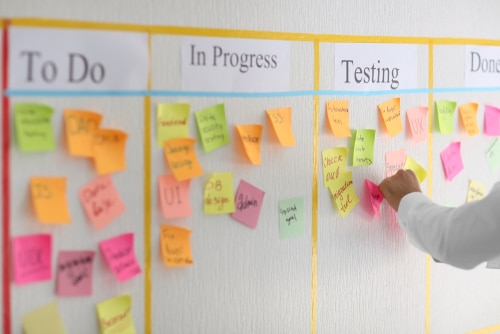How to use Kanban Method in Agile and DevOps development
Published on: November 4th, 2022
What is Kanban Methodology?
The Kanban methodology is widely used for implementing DevOps and Agile product development processes. It is a lean workflow management approach that defines and enhances work processes and helps agile and DevOps teams visualize workflows, improve continuously, and optimize efficiencies.
Specifically, development teams visualize work on Kanban boards enabling multiple teams to maximize work delivery and collaborate on sophisticated projects within a lone environment. Although it is popular among modern software development teams, the Kanban methodology is over fifty years old. It consists of workflow management strategies to assist companies in managing and improving work systems.
See how it works:
Ready to streamline your requirements management today?
How it Works
The Kanban project methodology uses Kanban boards identify to-do tasks, in-process tasks, and done tasks across an entire project and optimize workflow among the involved project team members. A Kanban Board is a signboard, showing your team’s work items organized by work completed, in progress and to be done.
Virtual Kanban boards are more effective for Agile software development processes than physical boards since they let multiple teams access visual workflows from different locations, have easier traceability, and have greater collaboration.
Development teams must visualize their work, standardize all workflows, identify existing dependencies and blockers and resolve them. A Kanban approach depends on real-time communication between various teams with full transparency. A Kanban is the single source of information for all teams involved in an Agile process.
A Kanban process also measures the completed work cycles using a Work in Progress (WIP) concept, which matches a team’s capacity to the amount of work to be completed. WIP limits are essential to ensure consistent standards, and teams must complete tasks in the order stated in the Kanban boards.

Kanban in Software Development
Agile and DevOps teams use the Kanban methodology in their software development processes to simplify the software development lifecycle. They use Kanban boards to visualize different development processes to manage and control the deployment of product features. This easy visualization helps them to ensure that the number of features being implemented equals the processes being completed.
Kanban also empowers development teams to develop a product in a single continuous development lifecycle. A Kanban framework uses the WIP (Work in Progress) limits to ensure the development teams focus on the necessary work amount at a given time. As developers complete their tasks, new tasks are assigned. WIP limits are defined based on the actual effort needed to complete the tasks versus the teams’ expected efforts.
Kanban Framework Practices
1. Workflow Visualization
The Kanban methodology visualizes workflows and works using Kanban boards and cards to ensure teams and individual developers understand the work in process and complete tasks to prevent risks that inhibit successful product delivery. Such risks include bottlenecks, blockers, queues, and other impediments. Workflow visualization permits individuals involved in product delivery to address the risks proactively to ensure a smooth flow of work.
2. WIP Limits
Multitasking is a common mistake for most developers since they often leave unfinished tasks and start new ones, risking the whole project being incomplete. Moreover, it leads to time wastage in context switching as they try to understand where they left off in the original tasks, introducing risks like prolonged waiting times, less productivity, long queues, and larger overheads.
Kanban therefore uses WIP limits in the work in process to ensure developers cannot start new tasks until the assigned ones are complete, thus preventing bottlenecks and waiting times.
3. Manage Flow
Kanban boards help development teams identify when work gets stuck. Factors that can halt flow include lack of tools, limited collaboration, inadequate training, and lack of process. The methodology identifies what developers should start or stop to manage the flow and keep the processes moving.
4. Enhance Collaboration
From the visualized processes in the Kanban boards, each development team is aware of its roles and responsibilities. Having a single source of truth ensures accurate distribution of workloads across all teams to eliminate confusion and enhance collaboration throughout the development lifecycle.
Kanban Methodology Benefits
- Flexible planning: Kanban enables various teams to focus on work in process and pick the next work item upon completion, ensuring efficient backlog management. Also, the product or project owner can reprioritize work when managing backlog without disrupting the team activities. Kanban lets product owners keep high-priority work items on top of the backlog to ensure that developers provide maximum value.
- Shorter time cycles: The time cycle metric is the time required for a team to complete a unit of work in its workflow. Kanban allows team members with different skill sets to reduce the time cycle since shared skills permit the team to work on heterogeneous work. If only a single team member has the skills required to complete a unit of work, that person becomes a bottleneck to the entire project. A Kanban framework ensures that all team members do their part concurrently to keep work moving.
- Reduced bottlenecks: Multitasking impedes efficiency since the more work items in a process, the greater the context switching, and the more the bottlenecks preventing project completion. Thus, a core tenet of the Kanban methodology is ensuring WIP limits to prevent developers from leaving unfinished tasks due to lacking skillsets, focus, or prolonged context switching.

How Modern Requirements Can Help
Modern Requirements solution for DevOps provides a single source of truth and extends a project into a full Requirements Management solution. Whether team members build diagrams or documents, our tools allow you to take any approach to create requirements. Whichever Modern Requirements4DevOps tool you use, every requirement you create will exist directly within your Azure DevOps project.
All of our authoring tools allow you to connect your existing requirements or can be used to author new requirements into your project. Take authoring a step further and use our automation tools to help your team generate User Stories, Use Cases, and Test Cases. These are vital to prioritizing work for different teams using a Kanban framework, allowing your DevOps teams the flexibility and visualization required to complete the project successfully.
Contact us today for a quote or for more information.

